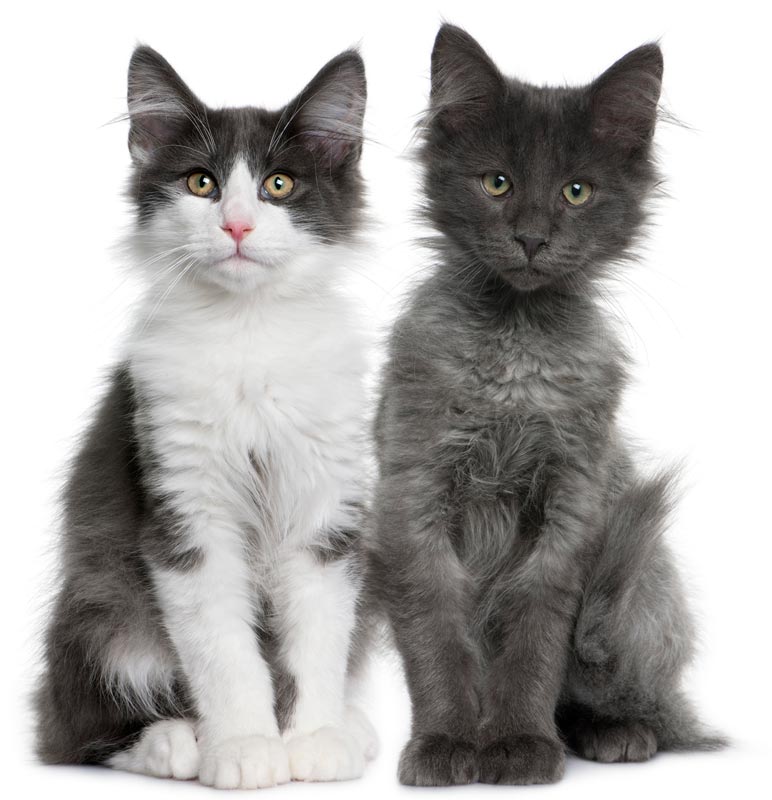Queen Cycling and Mating

Normal reproduction in a nutshell is all about high efficiency in the feline. Cats have always been recognized for their ability to reproduce—in Ancient Egypt they were worshiped as the worldly symbol for the Goddess of Fertility, Bastet. Cats of that era were so revered that they were often mummified and buried with their human families, and cemeteries were dedicated to the noble cat.
The average female cat will reach her first reproductive (estrous) cycleor heat when she is about 5-8 months of age, and about 2 kg body weight. Alley cats tend to reach maturity sooner than purebreds, and long-haired cats later than short-haired cats, but there are exceptions to this rule. Persian queens are late maturing, with sexual maturity averaging closer to 1-11/2 years of age, while Burmese and Siamese queens are early maturing, with onset of the cycling averaging about 4 months or so, thus breed will also affect the start of a queen’s reproductive years.
There is a very large range of what is normal when it comes to time frames for the domestic queen’s cycle. Generally, during the reproductive season which runs from about February to October in the continental US, a female will display estrous behavior every 14-21 days unless she becomes pregnant, ovulates without pregnancy (pseudo-pregnant), or becomes significantly ill. Siamese cats are more likely to cycle all the year round than other purebred cats, or alley cats.
The female’s cycles peak in early spring and mid-summer. This time frame is when the first and second litters begin their development in free roaming cats. The third litter arrives in late fall.
A female cat has a series of phases in this cycle:
The true heat, where she stands for the mating is called estrus. The estrus is preceded by a proestrus during which time she is progressing towards her receptive time, but will not accept a tomcat’s advances. As proestrus comes to an end, she becomes progressively more affectionate, will rub and roll, and may drop her forequarters and raise her tail if stroked over the topline from front to back. During this positioning, she may tread from side to side on her rear paws, and may call out to the male in a plaintive voice. Her appetite may be reduced, and she may pace. Proestrus lasts on average about 1-3 days. Once in estrus, she accepts the male for mating. This true estrus lasts about 3-7 days, though in some queens it can last for up to 19 days. Note that unlike bitches, there is no obvious discharge from the female, and in some queens, their behaviors are quite muted, making the determination of when she is coming into estrus quite a challenge. Other queens are so emphatic with their behaviors, some owners may believe the queen has hurt herself and is in pain!
If she does not become pregnant and does not ovulate, she enters interestrus, a period of rest which averages 1-2 weeks in length. During the peak breeding seasons of early spring and mid-summer, this rest period may be short or muted, so she might seem never to come out of season!
If she ovulates but does not become pregnant, a diestrus will follow. This phase averages about 35 days, and she will not show any breeding behaviors for a period averaging close to 50 days. A pseudo-pregnant cat will not show any signs favoring reproduction in this phase, and unlike bitches, will not usually show signs of the pseudo-pregnancy.
The winter quiet period is termed anestrus and will vary in length according to the geographic location.
Mating
The tomcat will reach his sexual readiness a bit later on average than the female, with onset of breeding behavior starting around 7-9 months of age. In controlled mating situations, the female cats are not bred until they have had a few cycles so that they are fully matured cats before they conceive. Free roaming queens will readily mate with more than one male in a cycle, and during their receptive period, will mate multiple times. This can result in kittens within a litter having more than one sire.
Cats prefer to mate at night, and the entire process is very quick, averaging only a few minutes long. She will call to the male with a special vocal sound only produced during the active part of her cycle, and the male will caterwaul back to her. After mating, the queen will let out what can only be described as a scream. She will fall down, lick herself furiously and roll around—if Tom tries to approach her right after mating she will strike out at him. She will be receptive again in about a half hour, though a usual mating interval is more like 1-2 hours. This pattern may continue for a few days, with gradually longer intervals between mating as she goes out of estrus.
Cats are known for their exceptional reproductive performance and rarely require the intervention of people to facilitate a successful breeding program. Now and then, behavioral issues will require action as a tom might be shy, or a female may show strong preference for a male that may not be first on the breeder’s list of “who’s who” for Tomfatherhood. Sometimes, infertility is a problem. Your veterinarian and local cat breeders are an excellent source of information on cat reproduction.
You May Also Like These Articles:
How to Care for Orphaned Kittens
Best Litter for Kittens: Is Clumping Litter Safe?
Notice: Ask-a-Vet is an affiliated service for those who wish to speak with a veterinary professional about their pet's specific condition. Initially, a bot will ask questions to determine the general nature of your concern. Then, you will be transferred to a human. There is a charge for the service if you choose to connect to a veterinarian. Ask-a-Vet is not manned by the staff or owners of CatHealth.com, and the advice given should not delay or replace a visit to your veterinarian.




